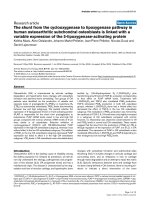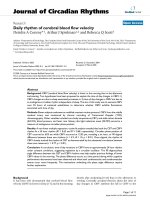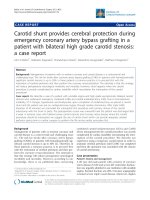Báo cáo y học: "Carotid shunt provides cerebral protection during emergency coronary artery bypass grafting in a patient with bilateral high grade carotid stenosis: a case report." ppsx
Bạn đang xem bản rút gọn của tài liệu. Xem và tải ngay bản đầy đủ của tài liệu tại đây (435.18 KB, 3 trang )
CAS E REP O R T Open Access
Carotid shunt provides cerebral protection during
emergency coronary artery bypass grafting in a
patient with bilateral high grade carotid stenosis:
a case report
John K Bellos
1*
, Nektarios Kogerakis
2
, Charalampos Kiriazis
2
, Alexandros Gougoulakis
1
, Matthew Panagiotou
2
Abstract
Background: Management of patients with co-existent coronary and carotid disease is a controversial and
challenging issue. Th e risk for stroke after coronary artery bypass grafting (CABG) in patients with hemodynamically
significant carotid stenosis is up to 30%. In these patients a common practice is to proceed first with the
restoration of cerebral perfusion and then perform the coronary revascularization. The rationale is that this strategy
will reduce perioperative neurological morbidity and mortality. However, what happens when the carotid
procedure is acutely complicated by cardiac instability which necessitates the interruption of the carotid
procedure?
Case report: We describe a case of a patient with unstable angina and high grade asymptomatic bilateral carotid
stenosis who underwent emergency combined CABG and carotid endarterectomy (CEA). Due to hemodynamic
instability, ST-T changes, hypotension and bradycardia, upon completion of endarterectomy we placed a carotid
shunt and the patient was put on cardiopulmonary bypass through median sternotomy. After triple CABG
(duration of 90 minutes) we concluded the interrupted CEA procedure with primary closure of the carotid
arteriotomy with the shunt in place. The postoperative course was uneventful and the patient was discharged after
a week. In extreme cases with bilateral severe carotid stenosis and coronary artery disease where the carotid
procedure should be interrupted, we suggest the use of car otid shunt which can provide adequate cerebral
perfusion giving time to cardiac surgeon to perform the life saving cardiac procedure first.
Background
Management of patient s with co-existent coronary and
carotid disease is a controversial and challenging issue
[1]. The risk for stroke after coronary artery bypass
grafting (CABG), in patients with hemodynamically sig-
nificant carotid stenosis is up to 30% [2]. Therefore, in
these patients a common practice is to proceed first
with the restoration of cerebral perfusion and then per-
form the coronary revascularization. The rationale is
that this strategy will reduce perioperative neurological
morbidity and mortality. However, according to our
knowledge, there is no published data concerning
combined carotid endarterectomy (CEA) and CABG
where intraoperatively the carotid procedure was acutely
complicated by cardiac instability necessitating the inter-
ruption of the carotid procedure. We describe our
experience using a temporary carotid shunt in order to
maintain cerebral perfusion until CABG was completed
and then the operation was concluded with the closure
of carotid arteriotomy.
Case presentation
Patient’s history and management
A 80 year old male patient with a history of coronary
artery disease (CAD) and severe left ventricular dysfunc-
tion was urgently admitted in our institution with unstable
angina. Ejection fraction was 20%. Coronary angiography
revealed severe triple vessel disease. Moreover, duple x
* Correspondence:
1
Department of Vascular Surgery, Athens Medical Center, 5-7 Distomou St,
15125, Marousi Athens, Greece
Full list of author information is available at the end of the article
Bellos et al. Journal of Cardiothoracic Surgery 2011, 6:33
/>© 2011 Bellos et al; licensee BioMed Central Ltd. This i s an Open Access article d istributed under the terms of t he Creative Co mmons
Attribution Lic ense ( es/by/2.0 ), which permits unrestricte d use, distribution, and reproduction in
any medium, prov ided the original work is properly cited.
ultrasound which was performed urgently in intensive care
unit (ICU), showed bilateral severe carotid stenosis (80-
90% stenosis and unstable plaque in the right internal car-
otid artery and 70-80% stenosis in the left side). Both ver-
tebral arteries were patent without reverse flow or any
significant hemodynamic changes. The patient continued
to be in unstable angina, therefore we decided to perform
emergency combined surgery without a preoperative
angiogram. After induction of general anesthesia the right
carotid bifurcation was exposed by a standard lateral
approach and simultaneously the left great saphenous vein
was harvested. Immediately after the completion of endar-
terectomy and before starting the closure of arteriotomy
the patient became hemodynamic unstable with ST-T
changes, bradycardia and hypotension. Under these condi-
tions we decided to interrupt the carotid procedure and
place a Javid carotid shunt (Bard Peripheral Vascular Inc,
AZ, USA), and immediately proceed with a median ster-
notomy and cardiopulmonary bypass (CPB) (Figure 1A).
We performed an emergency triple CABG with saphenous
vein grafts under extracorporeal circulation (ECC) and
moderate hypothermia (28°C). After the patient’s weaning
from CPB and his pressure stabilization (90 minutes later)
the CEA was completed with primary closure of ca rotid
arteriotomy (Figure 1B). The patient was transferred to
the ICU for one day and was discharged on the sevent h
postoperative day with improved left ventricular function
and without neurological complications.
Discussion
The optimal management of patients with combined
carotid and coronary artery disease remains controver-
sial. Various strategies have been proposed such as CEA
alone, or CABG alone, or staged CEA and CABG, or
staged carotid artery stenting (CAS) and CABG, and
simultaneous CEA and CABG, or simultaneous CAS
and CABG. In the majority of these approaches the
CEA or CAS precedes the CABG because it seems that
reduces the perioperative neurological morbidity and
mortality. We report a case where the CEA procedure
was interrupted by the CABG. The carotid procedure
was finished after the completion of the CABG. All
these handlings were possible through a temporary caro-
tid shunt which proved sufficient to maintain adequate
cerebral perfusion for 90 minutes. To our knowledge
prolonged cerebral perfusion through a sh unt during on
pump emergency CABG in patients with bilateral severe
carotid stenosis has not been previously reported.
Besides carotid artery stenosis, other stroke risk fac-
tors during CABG, frequently quoted in the literature,
are: ascending aortic atherosclerosis, previous stroke or
transient ischemic attack, age, hypertension, diabetes,
smoking, peripheral vascular disease, left ventricular dys-
function, left main CAD, renal failure, and increased
cardiopulmonary bypass time [3]. Our patient had t he
majority of these risk factors (age, left CAD, heavy smo-
ker in the past, left ventricular dysfunction, peripheral
Figure 1 Line drawings depict stages of the operative procedure: A) Due to hemodynamic instability we stopped the carotid
endarterectomy procedure, we placed a carotid shunt and we proceeded to emergency sternotomy, B) After the completion of 3 coronary
artery bypass grafting and patient’s weaning from cardiopulmonary bypass, we continued with the primary closure of carotid arteriotomy.
Bellos et al. Journal of Cardiothoracic Surgery 2011, 6:33
/>Page 2 of 3
arterial disease). The only preventive measure against
stroke were the carotid shunt, which proved to be ade-
quate, and the patent vertebral arteries.
In a recent case report the authors applied a 14 Fr
cannula into the distal part of the internal carotid artery.
A separate pump was connecte d in cannula and arterial
blood at 23°C was delivered at a flow rate of 300 ml/
min [4]. Although, based on classical findings, the nor-
mal carotid artery flow rate is 133-200 ml/min, the
appropriate flow rate of the active cerebral perfusion is
still unclear [5]. However, under CPB the cerebral auto-
regulation is severely impaired, thus a flow rate of 300
ml/min may result to hyperperfusion syndrome and cer-
ebral hemorrhage. Moreover, differences between our
technique and the previous mentio ned are obvious . Our
technique is less complicated, less expensive and less
time consuming. Therefore, our report suggests that a
carotid shunt could maintain cerebral perfusion and
could provide cerebral protection for at least 90 minutes
ECC in patient with high grade bilateral carotid stenosis.
Some surgeons prefer the off-pump CABG, especially
in patients with severe carotid disease [6]. Off-pump
CABG certainly has many advantages and in a recent
study an aorto-carotid shunt was used in patients who
underwent combined CEA and CABG with satisfactory
results [7]. However, in our case this was not feasible
because of patient’s hemodynamic instability.
Finally, the important role of the shunt in the cerebral
perfusion during CPB is enhanced by the fact that the
patient was under diminished systemic pressure, moder-
ate hypothermia and non pulsatile cerebral perfusion
from the pump for 90 minutes.
Conclusion
This case highlights the value of conventional carotid
shunt to maintain intra-operative cerebral perfusion
during emergency CABG in unstable patie nts with
sim ultaneous carotid and coronary disease. We propose
our technique as a bail-out trick in c ombined cases of
CEA and CABG when the endarterectomy cannot be
completed due to life threatening cardiac and hemody-
namic instability.
Consent
Written informed consent was obtained from the patient
for publication of this case report. A copy of the written
consent is available for review by the Editor-in-Chief of
this journal.
Acknowledgements
We would like to warmly thank Dr. Giannis Lazaridis for his valuable line
drawings.
Author details
1
Department of Vascular Surgery, Athens Medical Center, 5-7 Distomou St,
15125, Marousi Athens, Greece.
2
Department of Cardiac Surgery, Athens
Medical Center, 5-7 Distomou St, 15125, Marousi Athens, Greece.
Authors’ contributions
JB, AG, MP came up with original conception and design. JB, AG, MP, NK, CK
reviewed the medical literature, and were major contributors in writing the
manuscript. NK, CK formatted the media. All authors read and approved the
final manuscript.
Competing interests
The authors declare that they have no competing interests.
Received: 23 October 2010 Accepted: 20 March 2011
Published: 20 March 2011
References
1. Gugulakis A, Kalodiki E, Nicolaides AN: Combined carotid endarterectomy
and coronary artery bypass grafting. A literature review. Int Angiol 1991,
10:167-72.
2. D’Agostino RS, Svensson LG, Neumann DJ, Balkhy HH, Williamson WA,
Shahian DM: Screening carotid ultrasonography and risk factors for
stroke in coronary artery surgery patients. Ann Thorac Surg 1996,
62:1714-23.
3. John R, Choudhri AF, Weinberg AD, Ting W, Rose EA, Smith CR, Oz MC:
Multicenter review of preoperative risk factors for stroke after coronary
artery bypass grafting. Ann Thorac Surg 2000, 69:30-5.
4. Imanaka K, Kato M, Ogiwara M, Kyo S: Active cerebral perfusion during
carotid endarterectomy. Asian Cardiovasc Thorac Ann 2006, 14:e50-2.
5. Boysen G: Cerebral hemodynamics in carotid surgery. Acta Neurol Scand
Suppl 1973, 52:3-86.
6. Mishra Y, Wasir H, Kohli V, Meharwal ZS, Malhotra R, Mehta Y, Trehan N:
Concomitant carotid endarterectomy and coronary bypass surgery:
outcome of on-pump and off-pump techniques. Ann Thorac Surg 2004,
78:2037-42.
7. Rao PV, Hosabettu PK, Dhaded S, Mathew A, Punnen J, Kanchi M: Distal
carotid perfusion in combined carotid endarterectomy and OP-CABG.
Asian Cardiovasc Thorac Ann 2007, 15:164-6.
doi:10.1186/1749-8090-6-33
Cite this article as: Bellos et al.: Carotid shunt provides cerebral
protection during emergency coronary artery bypass grafting in a
patient with bilateral high grade carotid stenosis: a case report. Journal
of Cardiothoracic Surgery 2011 6:33.
Submit your next manuscript to BioMed Central
and take full advantage of:
• Convenient online submission
• Thorough peer review
• No space constraints or color figure charges
• Immediate publication on acceptance
• Inclusion in PubMed, CAS, Scopus and Google Scholar
• Research which is freely available for redistribution
Submit your manuscript at
www.biomedcentral.com/submit
Bellos et al. Journal of Cardiothoracic Surgery 2011, 6:33
/>Page 3 of 3









